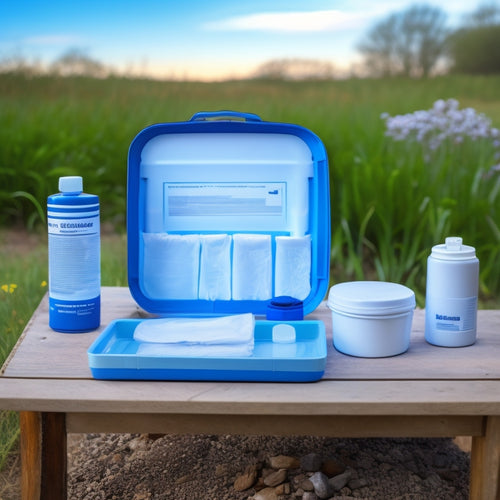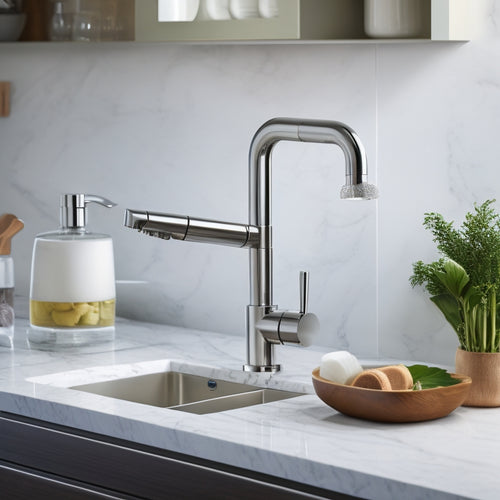
Declutter and Organize Your Kitchen Cabinets
Share
You're ready to tackle that cluttered kitchen cabinet chaos! Start by taking stock of what's inside and sorting items into categories. Evaluate your kitchen's unique needs and style to determine the ideal cabinet layout. Then, purge unwanted items and challenge those sentimental attachments - it's time to make room for joy-bringing essentials. Group items by category, prioritizing frequently used ones, and assign storage zones for easy access. Next, maximize vertical space with stackable containers and shelves. With these steps, you'll be well on your way to a functional, peaceful kitchen - and there's even more to discover to make your space truly shine.
Key Takeaways
• Take stock of kitchen cabinet contents and sort items into categories to evaluate storage needs and identify areas for improvement.
• Purge unwanted kitchen items to create a more functional space and make room for frequently used and joy-bringing items.
• Assign designated storage areas and divide cabinets into zones to ensure easy access to high-priority items and maximize storage space.
• Utilize vertical storage space by using stackable containers, shelves, and baskets to store infrequently used items strategically and effectively.
• Create a kitchen hierarchy to prioritize cabinet space and store frequently used items in easy-to-reach locations for optimal functionality.
Assessing Your Kitchen Cabinet Needs
Take stock of your kitchen cabinet contents by pulling everything out and sorting items into categories, like baking supplies, cookware, and dinnerware, to get a clear picture of what you have and where it should go. This step is important in evaluating your kitchen cabinet needs.
As you sort, think about your kitchen style and how you use your space. Do you have a large family and need more storage for dinnerware, or are you a solo cook who prioritizes cookware? Consider your cooking habits and the types of meals you prepare most often. This will help you determine the ideal cabinet layout for your kitchen.
Think about the items you use daily and those you use less frequently. You'll want to store your most-used items in easy-to-reach locations, while less-used items can be stored in higher or lower cabinets.
Purging Unwanted Kitchen Items
Your kitchen cabinets are only as organized as the items you decide to keep, so it's essential to purge unwanted kitchen items that are no longer useful, broken, or redundant. This step can be challenging, especially when it comes to items holding sentimental value or emotional attachment.
You might be tempted to keep your grandmother's old cookbook or the ceramic vase your aunt gave you, but ask yourself honestly if you've used them in the past year. If not, it's time to let them go. Remember, the memories attached to these items are what's truly important, not the physical objects themselves.
Take a photo of the item and let it go, or consider passing it on to someone who might appreciate it more. By purging these items, you'll create space for the things that truly bring you joy and make your kitchen a more functional and peaceful space.
Categorizing Kitchen Cabinet Contents
Organization emerges when you categorize your kitchen cabinet contents into groups that make sense for your cooking habits and needs. This essential step helps you create a kitchen hierarchy, where essentials are easily accessible and less-used items are stored out of the way.
Start by grouping similar items together, such as baking supplies, cooking utensils, and dinnerware. Then, prioritize your cabinet space by identifying the items you use most frequently. These high-priority items should be stored in easy-to-reach locations, while less-used items can be relegated to higher or lower shelves.
As you categorize, consider your cabinet priorities. Which items do you need quick access to during meal prep? Which items can be stored out of the way, but still be easily retrieved when needed?
Assigning Zones for Storage
Now that you've categorized and prioritized your kitchen cabinet contents, it's time to assign zones for storage, dividing your cabinets into designated areas that correspond to your cooking tasks and needs. This will help you create a smooth kitchen workflow, where everything has its place and is easily accessible.
Start by identifying the main cooking zones in your kitchen, such as baking, cooking, and food prep. Then, label each zone accordingly, using zone labels that resonate with you. For instance, you might have a 'Baking Station' or a 'Spice Station'.
Assign the items from your categorized lists to their corresponding zones, making sure that the items you use most frequently are stored in easy-to-reach locations. Consider the height and accessibility of each zone, ensuring that you're not straining to reach items or bending down excessively.
Utilizing Vertical Storage Space
With your zones assigned, it's time to maximize the often-wasted vertical space in your kitchen cabinets by using stackable containers, shelves, and baskets to store less frequently used items. This will help you make the most of your cabinet's storage capacity and keep your kitchen organized.
To maximize shelves, consider installing adjustable shelves or using shelf dividers to separate items. This will allow you to store more items in a smaller space and keep similar items together.
Don't forget to utilize the top shelves of your cabinets, which are often hard to reach. Install ladders or step stools to make it easier to access these areas. This will enable you to store infrequently used items, such as special occasion dishes or cookbooks, without taking up valuable space on lower shelves.
Investing in Dividers and Bins
You'll be amazed at how much more efficient your kitchen cabinets become when you invest in dividers and bins specifically designed to corral clutter and keep similar items grouped together. By incorporating these organizational tools, you'll create a sense of calm and control in your kitchen. No more digging through messy shelves or wasting time searching for that one ingredient.
Here are some essentials to contemplate:
-
Custom Dividers: Design them to fit your unique cabinet spaces, ensuring a snug fit for your cookbooks, dinnerware, or pantry staples.
-
Aesthetic Bins: Choose bins that complement your kitchen's style, from modern and sleek to rustic and charming.
-
Adjustable Compartments: Opt for dividers that can be easily rearranged as your storage needs change.
-
Stackable Containers: Select bins that can be stacked to maximize vertical storage and keep items out of the way.
-
Easy-to-Label Options: Incorporate dividers and bins with labeling capabilities, making it simple to identify what's inside.
Installing Shelf Liners and Inserts
Clarity and functionality converge when shelf liners and inserts are strategically installed in your kitchen cabinets. You've worked hard to declutter and organize your space, and now it's time to take it to the next level. Shelf liners and inserts can help keep your kitchen cabinets looking their best while also making meal prep and cleanup a breeze.
When choosing shelf liners, consider the materials that will work best for your needs. Adhesive-backed liners are great for wire shelves, while non-adhesive liners are perfect for solid shelves. Look for liners with a durable construction that can withstand spills and messes. You'll also want to think about the level of grip you need – some liners have a textured surface to prevent items from sliding around.
Inserts can also be a game-changer in your kitchen cabinets. They can help keep items like plates, bowls, and cups organized and easy to access. Choose inserts that fit your cabinet's dimensions and are made from durable materials that can withstand daily use.
With shelf liners and inserts in place, you'll be able to find what you need quickly and easily, making cooking and entertaining a joy.
Maintaining Your Organized Cabinets
By establishing a few simple habits, you can guarantee your newly organized kitchen cabinets remain clutter-free and functional over time.
To maintain your hard-won organization, incorporate these daily habits into your routine:
-
Put things back: After cooking, make it a habit to put away utensils, gadgets, and ingredients in their designated spots.
-
Wipe down shelves: Clean up spills and crumbs immediately to prevent them from becoming sticky, stubborn messes.
-
Purge regularly: Set aside time each week to get rid of expired or unused items, keeping your cabinets fresh and relevant.
-
Schedule seasonal refreshes: Plan to reassess and reorganize your cabinets every 3-4 months to accommodate changing seasons and cooking habits.
-
Keep it up: Make maintenance a family affair by assigning tasks to household members, ensuring everyone is invested in keeping your kitchen cabinets organized and clutter-free.
Frequently Asked Questions
How Do I Prevent Clutter From Building up Again in the Future?
To avoid clutter's creep, you'll form habits like regular tidying and implement a maintenance routine, ensuring your space stays organized and peaceful, making you feel more in control and connected to your belongings.
Can I Use DIY Dividers or Should I Purchase Custom Ones?
You're deciding between DIY dividers and custom ones. Consider material options like wood, plastic, or metal, and divider styles like adjustable, fixed, or stackable. Choose what fits your needs and style to create a functional space that feels like you.
Are There Any Specific Cabinet Organizers for Corner Spaces?
As you navigate the labyrinth of your kitchen, corner spaces can be a puzzle. You'll find the missing piece with Corner Carousels or Adjustable Shelves, designed to maximize storage and accessibility, helping you create a harmonious kitchen haven that feels like home.
How Often Should I Clean and Dust My Kitchen Cabinets?
You'll want to commit to regular cabinet maintenance, dusting every 1-2 weeks and deep cleaning seasonally for a fresh, welcoming space that feels like home - it's a great way to keep your kitchen feeling refreshed and organized!
Can I Organize My Kitchen Cabinets on a Limited Budget?
"When in doubt, start small," they say. You can organize your kitchen cabinets on a limited budget by embracing budget-friendly alternatives and thrifty solutions, like repurposing containers and utilizing vertical space, to create a functional and stylish kitchen.
Related Posts
-

Newlyweds' Zola Registry: Top Picks Unveiled
Newlyweds can now effortlessly create their dream home with Zola's expertly curated registry picks. For a warm and in...
-

Emergency Sanitation Essentials for Your Needs
In emergency situations, access to proper sanitation facilities is essential for maintaining personal hygiene, preven...
-

Revolutionize Your Kitchen Sink With Must-Haves
Elevate your kitchen sink experience with must-have essentials that prioritize organization, efficiency, and style. S...


